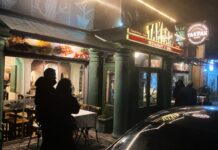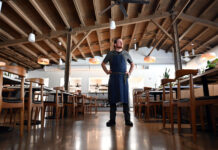The following “old” Albanian beer-everie is excerpted from my ongoing online memoir, first appearing on July 29, 2024: 40 Years in Beer (Book II) Part 54: New Albanians on beer holiday in Old Albania (1994). Albania in 1994 was a traumatized country in recovery — from decades of communism and centuries of mountainous isolation. It was enough to make a tourist awfully thirsty, and during my first visit, two brewery tours highlighted the long road yet to be traveled by Albania’s nascent brewing industry.

The Korçë Brewing Experience.
The history of commercial brewing in Albania is confined to the decades since 1900. There is no evidence to indicate that beer was a factor during five centuries of Turkish domination, although wine and raki (indigenous firewater) make appearances throughout pre-20th century Albanian history and lore.
For the record, raki is the chill-relieving, euphoria-promoting and paint-thinning social beverage of choice in Albania, and the Albanian wines we tasted were honest, if not spectacular, alternative beverages.
The first commercial brewery in Albania in the 20th century was built in 1928 by an Italian company in the southeastern city of Korçë (KOR-che). The city is located in a fertile agricultural valley nestled in rugged mountains and is renowned for commerce (ancient trading routes with Greece and Macedonia), erudition (the first Albanian language school was founded in Korçë), ethnic culture, and as a hotbed of Albania’s 20th-century quest for national identity.
We found the decaying brewery on a tree-lined avenue at the outskirts of the compact city. Bulky iron gates bore the “Birra Korçë” name in simple, red block letters. On the side of a building several yards away, a curiously pristine Communist-era historical marker noted the heroic action of anti-fascist partisans in 1945, who helped to liberate the area by burning some of the brewery’s storage buildings.

As Agim translated the words, I asked myself: How could this really be a victory if the beer wasn’t liberated prior to the destruction of its home? Certainly the ideological struggle against capitalism might be suspended for a few rounds prior to the lighting of the arsonist’s torch?
The Korçë brewery reeked of faded, degraded elegance. It was constructed in the traditional tower layout, with the barley conveyed to the top for milling, the mash tun and brew kettle taking up the middle, and the fermenters and lagering tanks at the bottom. The mustard-colored, green-trimmed buildings seemed in decent shape in spite of recent neglect, but conditions were chaotic on the day of our visit.
A horse and several dogs roamed the compound, and mounds of rusted machinery, a staple feature of the contemporary Albanian landscape, littered the yard. Inside, some windows were patched with cardboard and there were more than a few puddles formed by leaking pipes.

Yet, in spite of it all, the brewery at Korçë (the only one in Albania with a tradition of excellence, according to Agim) was slowly shuddering back to life following a period of dormancy since the collapse of Albania’s economy. The brewery was being revived by a consortium of eleven investors who had been victims of political persecution during the Communist era and who, as a form of settlement, were given a competitive advantage during the bidding procedure to privatize industry.

On the day of our visit, the Korçë brewery’s first test batch of the new era was boiling in the kettle. The new owners had to overcome formidable obstacles just to arrive at the point of brewing. The brewery was somewhere in the middle of the renovation process as we toured the building, and it had the littered appearance of a construction site. We were told that until the European Union chipped in several thousand cases of used, East German half-liter beer bottles, there was nothing in which to actually package the beer, although a few dozen antique wooden kegs were left behind.

We briefly met with three of the new owners before departing. One of them worked in the brewery before and was now the brewmaster; he told us that they hoped to resurrect Birra Korçë’s three styles: 12-degree pilsner, 12-degree dark lager and a special 14-degree lager. The pilsner would come first.

Interestingly, the Albanian adjective used to describe a “dark” was black, and my curiosity was aroused. To the north, Albania borders on Montenegro (“Black Mountain”), a former Balkan kingdom and Yugoslav republic that became independent in 2006, and more importantly, was the birthplace of fictional detective Nero Wolfe, conceived after an affair in 1892 between Sherlock Holmes and Irene Adler.
Marketing possibilities flowed liberally through my mind as we sat in the old, musty, high-ceilinged office and listened to the brewmaster explain his choice of German hops, Italian malt and yeast obtained at the same brewery in Athens where Amstel is brewed under license.
I left with the impression that the consortium would be able to pull it off and put Birra Korçë back on the brewing map, and in fact they held onto the brewery until 2004, when a nouveau riche Albanian magnate purchased it.
To judge from current photos, the ensuing modernization has been complete and all-encompassing, inside and out, and the brewery looks like Disneyland. If the fellows we met that day so along ago sold out and got paid, I’m happy for them.
After all, it isn’t easy.

 Back in the Brewing Business in Tirana.
Back in the Brewing Business in Tirana.
In contrast to the brewery at Korçë, the plant dating from 1960 in Albania’s capital city of Tirana was utilitarian, a white-tiled facility resembling a dairy more than a brewery. It was built with Soviet assistance, and looked it.
Our ride from the port city of Durrës to the brewery in Tirana took us past rustic villages, abandoned and dilapidated concrete irrigation channels, wandering herds of livestock, Albania’s sparkling new Coca-Cola bottling plant, row after row of shabby socialist tenements, and finally a vast lot where the burned-out remains of the city’s Communist-era bus fleet reposed in blackened, skeletal queues.
At the time of our visit, the Birra Tirana brewery hadn’t yet been privatized (and wasn’t until 2001), but at least it had resumed production. Upon arriving at the gate, we encountered a reluctance to let us enter; this was typical. Eventually a wiry, chain-smoking worker with an impressive five o’clock shadow and darting, nervous eyes took an interest in us and went off in search of the plant director, who couldn’t be found. By that time we were inside, Genci having persuaded someone to make a decision and let the foreigners escape the blazing midday sun.

Minutes later, we met the “lost” director in the hall, and he hastily grunted retroactive permission to enter, no doubt thanking his lucky stars that he no longer lived in a nation where negligence determined by coin flip might be greeted with a trip to the eastern Albanian ore mines or the dungeon-like prisons of the citadel in Gjirokastra, with its handy rooftop garden once used by firing squads, but now serving as a convenient point from which to survey the ancient hilltop town and surrounding mountains.
We were met by a friendly, diminutive brewmaster who happily led us around the sparse, functional plant and answered questions through our interpreter. Like the older brewery in Korçë, Tirana’s brewery had ceased to function for quite some time. According to the employees, it closed because the former brewery bureaucrat had been paid off by entrepreneurs who were engaged in importing Macedonian Skopsko Pivo and were intent on eliminating the local competition.
Only one beer, a Czech-style pilsner, was being brewed at the time of our visit. Hops were being purchased from Germany, and barley and yeast from Italy. The yeast was being cultured in a bare-bones laboratory, where a batch foamed merrily in a kitchen-sink-sized steel receptacle.

After 5 to 7 days of primary fermentation, the beer is pumped into the secondary tanks in the basement for 21 days of lagering at near-freezing temperatures. As we enjoyed the comfortable contrast in temperature afforded by the frigid lagering cellar, the brewmaster’s assistant tapped off some two-week old, unfiltered “Hoxha’s Best” and proudly offered glasses to us. The beer was crisp and nicely defined, far tastier than most of the Italian imports on sale in Albania.

Later we sampled the filtered, bottled, final 11-degree product and noticed the lack of labels; they hadn’t gotten to those yet, but hoped to soon (as identification, the brewery logo was displayed on the bottle caps). Appropriately, the beer was priced to sell below the lowest-priced imports, a sound strategy in a country as poor as Albania. On both sampling occasions, first in the cellar and then at the bottling line, we were joined in our tasting by that wiry, nervous employee from the guard shack, who had accompanied us on the entire route through the brewery.

As we surveyed the women from the bottling line, who were taking a break as the line underwent repairs, I spotted our chain-smoking friend discretely posted behind a machine, taking a final, furious drag on his cigarette as he removed the cap from an unguarded bottle and drained most of it in one swallow. In my view, it was a well-deserved reward for being responsive to the visitors, and I thanked him.
The excerpt ends here; to read the whole story, visit my website. As of 2024, there is a beer scene in Albania, and these two Norwegians would like to guide you through it. As of 2025, I’m in Tirana for my first return trip since 1994.
Previously at “Hip Hops”:
Hip Hops: Pivo in Skopje with the greatest seismologist of them all (1987)




















 Roger Baylor is an entrepreneur, educator, and innovator with
Roger Baylor is an entrepreneur, educator, and innovator with 





